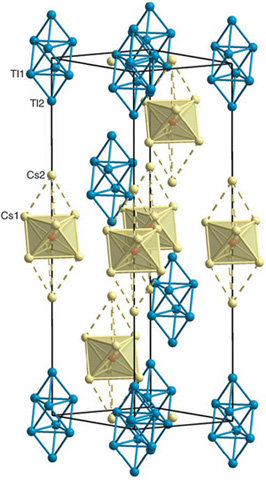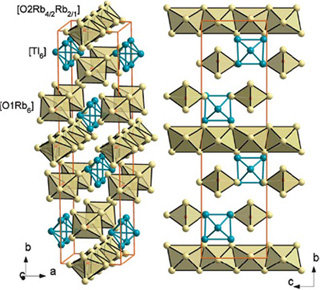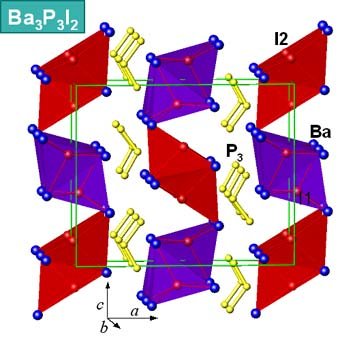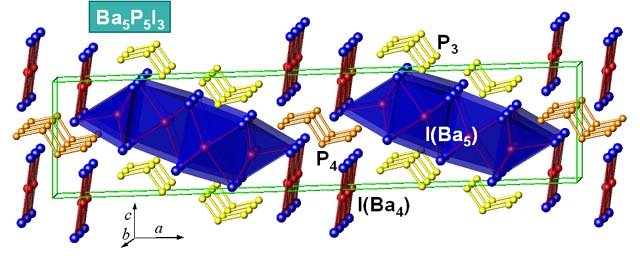
Oxidation of Zintl phases
Jürgen Nuss, Sabine Prill-Diemer, Fei Wang, Ulrich Wedig
Motivation
Using NaTl as an example, Zintl developed the concept that was later named after him, and which was subsequently generalized by Klemm. The Zintl-Klemm concept belongs to one of the most successful concepts in solid state chemistry. Assuming that all valence electrons of a donor (metal) were transmitted to an acceptor (nonmetal or semimetal), one can understand and predict essential elements of the topologies of the resulting anionic partial structures, in boundary of metallic and ionic bonding. The most frequently used tool to control the connectivity of the anionic partial structure is the variation of the ratio metal / nonmetal in the compound, and therefore the direct tuning of the valence electron concentration at the anions. Another possibility is the oxidation or reduction of an already existing Zintl phase (Barium phosphides), or the use of oxygen as a third component to generate a further degree of freedom (Thallides).
Ba3P3I2 and Ba5P5I3: stepwise oxidation of barium phosphide with iodine
The Zintl phases Ba3P2 with isolated P3– ions or Ba4P3 which contains P3– ions and P24– dumbbells, react with iodine in a direct way to Ba3P3I2 and BaI2 (eq. (1) and (2)). A characteristic detail of the new compound are P3 chains; therefore an oxidation of the anionic partial structure results. The consequence is a P—P bonding formation and an enlargement of the phosphorus chains. The reaction was carried out at 1050 K, which is obviously below the melting points of the binary phosphides. Thus, the planned oxidation of a Zintl anion in the solid phase could be successfully realized.
To avoid the formation of BaI2 as a byproduct, a mixture with the composition 'BaP', containing Ba3P2, Ba4P3 and Ba3P4 can be used, too (eq. (3)). The use of P2I4 as an oxidation reagent is also possible (eq. (4)).(1) 3 Ba3P2 + 5 I2 ---> 2 Ba3P3I2 + 3 BaI2
(2) Ba4P3 + 2 I2 ---> Ba3P3I2 + BaI2
(3) 3 BaP + I2 ---> Ba3P3I2
(4) 2 Ba3P2 + P2I4 ---> 2 Ba3P3I2
Reducing the amount of iodine has a direct influence on the anionic partial structure. Therefore one obtains, when using the composition Ba3P 3I1.8 the new compound Ba5P5I3, which contains additional P4 chains besides P3.
The new compounds Ba3P3I2 and Ba5P5I3 are sensitive to air and moisture. They crystallize in new structure types: Ba3P3I2 (oP32; Pnma; a = 1719.5(5) pm; b = 462.4(2) pm; c = 1427.2(4) pm; Z = 4, Ba5P5I3 (mC52; C2/m; a = 4266.4(13) pm; b = 456.3(2) pm; c = 943.1(3) pm; β = 92.20(3)°; Z = 4. Both can be described as double salts of hypothetic Zintl phases ('Ba2P3' or 'Ba7P10') and a halide (BaI2). Characteristic structural features are P3 and P4 chains, corresponding to Ba3[P3]I2 and Ba10[P3]2[P4]I6, respectively.
This example of the oxidation of barium phosphide with iodine shows, that this concept works with solid Zintl phases, too. The electron configuration of, e. g., P2– or P3– corresponds to that of a halogen or a halide, respectively. During the oxidation one moves to the left in the periodic table, and the connectivity increases.
Alkali metal thallide oxides
Cs8Tl8O
|
 |
A10Tl6O2 (A = K, Rb)
|
 |
J. Nuss, M. Jansen: On the Rare Earth Metal Bismuthide Oxides RE2BiO2 (RE = Nd, Tb, Dy, Ho)
Z. Anorg. Allg. Chem. 638 (2012) 611-613. doi:10.1002/zaac.201100529V. Saltykov, J. Nuss, U. Wedig, D. L. V. K. Prasad, M. Jansen: First isolated “hypoelectronic” [In6]6– cluster in insulating Cs22In6(SiO4)4
Z. Anorg. Allg. Chem. 637 (2011) 834-839. doi:10.1002/zaac.201100074V. Saltykov, J. Nuss, U. Wedig, M. Jansen: Regular [Tl6]6– Cluster in Cs4Tl2O, Exhibiting Close Shell Configuration and Energetic Stabilization due to Relativistic Spin-Orbit Coupling
Z. Anorg. Allg. Chem. 637 (2011) 357-361. doi:10.1002/zaac.201000405V. Saltykov, J. Nuss, M. Jansen: Cs10Tl6SiO4, Cs10Tl6GeO4 and Cs10Tl6SnO3 — First Oxotetrelate Thallides Containing "Hypoelectronic" [Tl6]6– Clusters
Z. Anorg. Allg. Chem. 637 (2011) 1163-1168. doi:10.1002/zaac.201000358V. Saltykov, J. Nuss, U. Wedig, M. Jansen: Impact of Spin-Orbit Coupling on the Structure of Thallium Clusters
Z. Anorg. Allg. Chem. 636 (2010) 2040. doi:10.1002/zaac.201008005U. Wedig, V. Saltykov, J. Nuss, M. Jansen: Homoatomic stella quadrangula [Tl8]6– in Cs18Tl8O6, Interplay of Spin-Orbit Coupling and Jahn-Teller Distortion
J. Am. Chem. Soc. 132 (2010) 12458-12463. doi:10.1021/ja1051022J. Nuss, M. Jansen: BaAuP and BaAuAs, Synthesis via Disproportionation of Gold upon Interaction with Pnictides as Bases
Z. Anorg. Allg. Chem. 635 (2009) 1514-1516. doi:10.1002/zaac.200900070J. Nuss, M. Jansen: Crystal structure of terbium antimonide oxide, Tb9Sb5O5
Z. Kristallogr. NCS 224 (2009) 11-12. doi:10.1524/ncrs.2009.0007J. Nuss, M. Jansen: Syntheses, structures and properties of the pnictide oxides R2PnO2 (R = Ce, Pr; Pn = Sb, Bi)
J. Alloys. Comp. 480 (2009) 57-59. doi:10.1016/j.jallcom.2008.09.181J. Nuss, M. Jansen: Reticular merohedral twinning within the La9Sb5O5 structure family: structure of Pr9Sb5O5, Sm9Sb5O5 and Dy9Sb5O5
Acta Crystallogr., Sect. B: Struct. Sci. 63 (2007) 843-849. doi:10.1107/S0108768107051282A. Karpov, M. Jansen: A10Tl6O2 (A = K, Rb) cluster compounds combining structural features of thallium cluster anions and of alkali metal sub-oxides.
Chem. Commun.(2006) 1706-1708. doi: 10.1039/b601802eA. Karpov, M. Jansen: [Tl8]6- in Cs8Tl8O: A Naked Eight-Vertex closo-Deltaeder as a Cluster Anion.
Angew. Chem. 117 (2005) 7813-6. doi: 10.1002/ange.200502283; Angew. Chem. Int. Ed. Engl. 44 (2005) 7639-43. doi: 10.1002/anie.200502283J. Nuss, M. Jansen: Ba3P3I2 and Ba5P5I3: Stepwise Oxidation of Barium Phosphide with Iodine.
Z. Anorg. Allg. Chem. 629 (2003) 387-393. doi:10.1002/zaac.200390064

